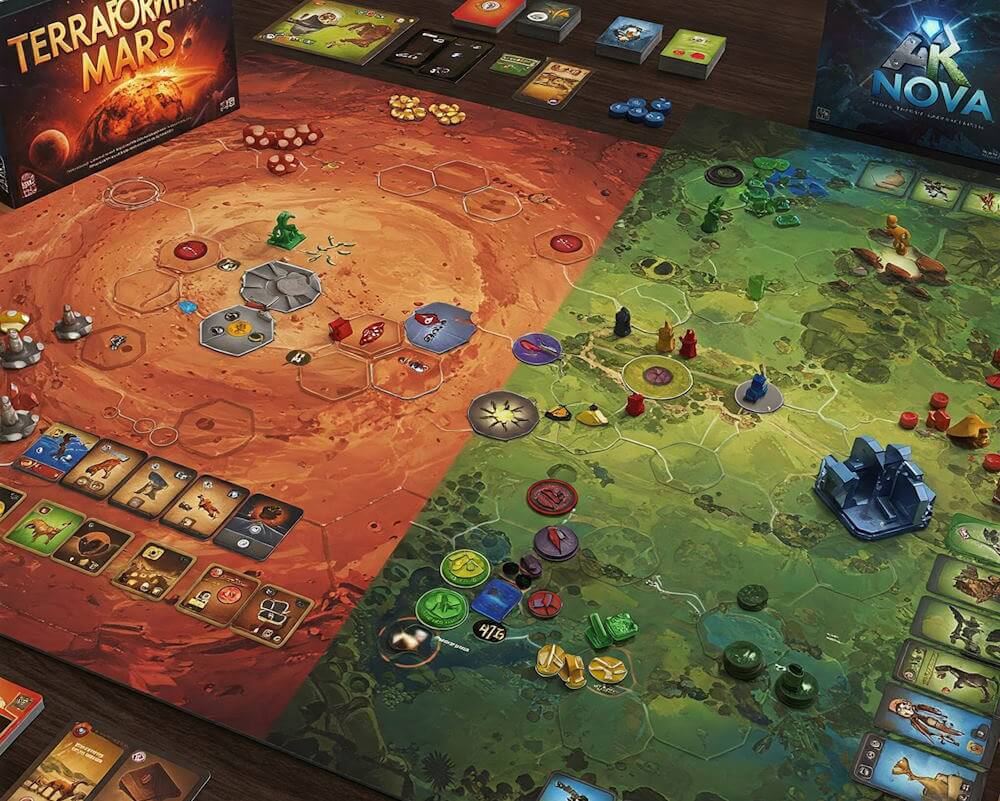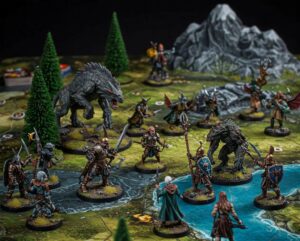Engine-building games are a distinct genre within board gaming that focus on players creating and optimizing their own systems to generate resources or achieve specific goals. In contrast to other gaming genres that might prioritize direct competition, luck-driven mechanics, or narrative elements, engine-building games emphasize strategic planning and long-term development. Players must carefully allocate resources, engage in decision-making processes, and build upon prior actions to enhance their gameplay experience.
The fundamental mechanics of engine-building involve the gradual construction of a complex system where players develop their own “engines”—combinations of actions, resources, and abilities that work together seamlessly. This progression allows players to engage in what is essentially a self-directed journey toward efficiency and effectiveness. The appeal of these games lies in the significant player agency they provide, allowing individuals to craft unique strategies based on their choices and the dynamics of the game. This depth invites a wide range of tactics and adaptations, making each session distinct and interactive.
Moreover, engine-building mechanics promote strategic thinking, problem-solving, and adaptability, as players are required to respond to evolving game states and the actions of their opponents. Players must consider how various components can synergize, leading to rewarding outcomes when executed effectively. This thoughtful gameplay experience creates a sense of ownership and accomplishment as players witness their engines evolve and become more powerful throughout the course of the game.
In this blog post, we will specifically examine two popular titles within the engine-building genre: Terraforming Mars and Ark Nova. These games exemplify the fundamental characteristics of engine-building gameplay while also offering unique themes and mechanics, setting the stage for an in-depth comparison of their strengths and appeal.
Overview of Terraforming Mars
Terraforming Mars is a strategic board game designed by Jacob Fryxelius, set in a futuristic scenario where players take on the roles of corporations tasked with transforming the barren landscape of Mars into a habitable environment suitable for human life. The game utilizes a rich thematic backdrop that intertwines scientific concepts with strategic gameplay, creating a captivating experience for players.
At its core, Terraforming Mars is an engine-building game, where players develop their own unique strategies through card-driven mechanics. Each player starts with a corporation that provides distinct advantages, which diversifies the gameplay and encourages various tactical approaches. The game revolves around a series of actions that allow players to gather resources, which are essential for card purchases, project executions, and, ultimately, terraforming the planet. The primary resources include megacredits, steel, titanium, plants, and energy, each playing a critical role in the overall strategy to maximize efficiency and point accumulation.
Resource management is a fundamental aspect of Terraforming Mars. Players must carefully balance their incomes and expenditures to ensure sustainable growth. The game involves various cards representing projects, events, and technologies that players can invest in, resulting in tangible improvements to Mars’ conditions. Key metrics, such as temperature, oxygen level, and ocean coverage, serve as benchmarks for progress, pushing player engagement through competition and collaboration.
Interaction among players is another significant feature, as they can directly or indirectly influence one another’s strategies. Whether through competing for projects, hindering progression, or forming temporary alliances, the dynamics foster a vibrant atmosphere of tactical maneuvering. In summary, Terraforming Mars combines its engaging theme with robust mechanics to create an experience where strategic thinking and resource management are paramount to achieve the ultimate goal of making Mars a livable planet for humanity.
Overview of Ark Nova
Ark Nova is a strategic board game that immerses players in the experience of building their own zoos, blending unique gameplay mechanics with thematic elements centered around conservation and animal welfare. The game distinguishes itself from other engine-builders through its innovative card-drafting and action-selection systems, which create a multifaceted experience that challenges players to balance multiple objectives. In Ark Nova, each player takes on the role of a zoo architect, tasked with designing and managing an expansive zoological garden.
At the heart of Ark Nova’s gameplay is its dynamic card-drafting system. Players acquire various cards representing animals, enclosures, and facilities. Each card has distinct attributes, influencing how they interact with one another and contribute to the overall functioning of the zoo. The careful selection of cards is crucial as players strive to meet specific goals, such as attracting visitors, ensuring the welfare of the animals, and promoting conservation efforts. This system allows for diverse strategies, as players can tailor their zoos to focus on different aspects of animal care and education.
The action-selection mechanism in Ark Nova further enhances its strategic depth. Players can choose from a variety of actions, including building enclosures, managing resources, and implementing conservation projects. The timing of these actions is essential, as players must navigate between expanding their zoos and maintaining a sustainable environment for the animals they house. Moreover, the game places a significant emphasis on conservation, encouraging players to consider the ecological impact of their decisions. Overall, Ark Nova’s combination of engaging mechanics, thematic relevance, and competitive strategic elements makes it a distinctive entry in the genre of engine-builders, appealing to players who appreciate both strategy and meaningful gameplay.
Comparative Gameplay Mechanics
When comparing the gameplay mechanics of Terraforming Mars and Ark Nova, it is essential to recognize the unique approaches each game takes towards resource collection, action economy, and card synergy. In Terraforming Mars, players are tasked with transforming the Martian landscape into a habitable environment while competing for resources such as plants, steel, and energy. Each turn, players can take actions to gain these resources, engage in project development, or increase their terraforming ratings, all revolving around a carefully structured action economy.
In contrast, Ark Nova places players in the role of zoo managers, where the goal is to create a sustainable zoo that maximizes visitors and conservation efforts. Resource management in Ark Nova includes animals, conservation points, and income, providing a distinct twist on engine-building mechanics. Action economy in this game operates through a unique action board that allows players to choose from a variety of actions, such as adding new enclosures, managing animals, or conducting sponsorships. Each action is linked to a corresponding action card, creating dynamic gameplay opportunities based on players’ strategic choices.
Card synergy is integral to both games, yet each implements it in different ways. In Terraforming Mars, players obtain project cards that can contribute to terraforming objectives or bolster resource generation. The key lies in the interaction between the cards and how they can be synergized to maximize the player’s engine. For instance, certain cards can complement each other by enhancing terraforming capabilities while others may support resource generation or synergize with specific corporation traits. Alternatively, Ark Nova’s cards influence zoo management directly while allowing players to build their strategy around attracting animals and achieving conservation goals.
Overall, while both Terraforming Mars and Ark Nova share the core theme of engine-building, the nuances of their gameplay mechanics reveal distinct strategies and depth, each appealing to different player preferences.
Thematic Elements and Immersion
The thematic richness of a game can significantly enhance the player experience, influencing both immersion and engagement levels. In this comparison, we examine the thematic elements present in two prominent engine-building games: Terraforming Mars and Ark Nova. Each game offers a unique setting and narrative, which shapes the overall atmosphere and player involvement.
Terraforming Mars is set in a futuristic vision of our solar system, in which players take on the roles of corporations aiming to transform the Martian landscape into a habitable environment. The game’s mechanics are heavily intertwined with its theme; players must engage in activities such as raising the planet’s temperature, creating oceans, and developing greenery. Each card represents technological advancements or projects that echo real scientific progress, which deepens immersion. The integration of scientific concepts and strategies allows for a narrative-driven experience, with players feeling as if they are part of a larger mission in humanity’s exploration and colonization of other planets.
In contrast, Ark Nova presents players with a different thematic focus, centered on building and managing a modern zoo while prioritizing conservation efforts. This game operates under a theme of ecological stewardship, engaging players in decisions that not only promote entertainment but also highlight the importance of sustainability and animal welfare. Ark Nova’s narrative unfolds through various conservation projects, allowing players to connect with real-world environmental issues. The game’s immersive qualities stem from its emphasis on intricate planning and the interplay between different habitats and species, invoking a sense of responsibility towards nature.
Player feedback underscores the importance of thematic coherence in both games. Many have noted that the immersion level in Terraforming Mars is enhanced by its scientific themes, while Ark Nova’s focus on conservation encourages players to reflect on real-world ecological challenges. Ultimately, both games successfully intertwine their themes with engine-building mechanics, drawing players into their respective worlds and elevating the overall gameplay experience.
Art and Components Quality
When evaluating tabletop games, the quality of art and components plays a crucial role in enhancing the overall gaming experience. In the case of Terraforming Mars, the artwork employs a blend of realistic and imaginative visuals that vividly depict the planet’s transformation. The board is intricately designed, showcasing expansive terrain, cities, and other locations rich with subtle details. The card art features a diverse range of illustrations reflecting the various projects and technologies, which further captivates players. However, some have noted that the graphics, while charming, can occasionally feel cluttered, particularly on the player boards which may detract from gameplay clarity.
In contrast, Ark Nova offers an art style that combines vibrant colors with an almost cartoonish flair that draws players into its world. The component quality is notably high, with thick, durable cards and a beautifully illustrated game board that facilitates easy comprehension of its numerous mechanics. Each token and animal card is produced with care, ensuring that they are not only visually appealing but also sturdy enough for repeated use. This attention to detail contributes to a more immersive atmosphere, as players engage in the unique conservation project theme.
Component functionality also plays a vital role in the user experience. In Terraforming Mars, while some components might feel basic, they serve their purpose well in tracking various metrics and resources. Meanwhile, Ark Nova excels in providing a streamlined experience through its well-designed player boards, which enhance the management of resources and actions. Overall, both games present quality art and components that reflect their themes and mechanics effectively, contributing to the enjoyment and replayability of the games. Understanding these artistic choices can enhance appreciation for each game, making them both significant contenders in the engine-building genre.
Player Interaction and Strategy
Player interaction in both Terraforming Mars and Ark Nova significantly shapes the strategies players employ throughout the games. In Terraforming Mars, the competition is palpable; players are constantly vying for limited resources and placement opportunities. Every move can affect another player’s progress, leading to a critical evaluation of both personal strategies and those of opponents. Players might engage in strategic blocking by claiming key tiles on the board, which can hinder an opponent’s ability to terraform or generate resources effectively. This competitive edge creates a tense atmosphere, encouraging players to not only focus on their engine-building but also to keep an eye on rivals’ developments.
Furthermore, the game allows for resource theft through various cards and actions, introducing an additional layer of complexity. One player’s advancement might necessitate the disruption of another’s plan, prompting alliances or conflicts that shift throughout the gameplay. Thus, understanding the dynamics of player interaction fosters a deeper appreciation for the strategic decisions that must be made. The interdependence of players means that each person’s strategy can significantly influence the others, heightening the experience and challenge.
In contrast, Ark Nova offers a different approach to player interaction. While it also involves competition, Ark Nova incorporates elements of collaboration. Players can exchange resources or partner on certain goals, which can lead to mutual benefits. This element of cooperation allows for a balance between competitive and collaborative strategies. Players can decide whether to focus on their individual engine-building or to coordinate efforts that can lead to shared victories. Hence, the player dynamics in Ark Nova encourage a mix of competition and collaboration, which diversifies the strategic options available to players.
Ultimately, both Terraforming Mars and Ark Nova highlight the significance of player interaction in engine-building games. The unique ways in which players can compete, cooperate, and influence one another’s progress create diverse strategic possibilities, enriching the overall gaming experience.
Community Reception and Popularity
The reception of both Terraforming Mars and Ark Nova within the board gaming community offers valuable insights into their popularity and enduring appeal. Terraforming Mars, released in 2016, quickly established a solid foothold in the gaming world, achieving high ratings on platforms such as BoardGameGeek. Many players appreciate its complex mechanics, thematic depth, and strategic options, which allow for a diverse array of play styles. The game’s ability to engage players in a cooperative yet competitive environment has contributed to its continued popularity, as evidenced by numerous expansions that further enrich the gameplay experience.
In contrast, Ark Nova, released in 2021, has garnered significant attention for its innovative mechanics and unique approach to the engine-building genre. Players have particularly praised the game for its engaging theme, centered around managing a wildlife park and ensuring biodiversity. The strategic depth combined with a satisfying progression system makes Ark Nova stand out, resulting in high ratings and numerous favorable reviews. Community discussions often revolve around the seamless integration of mechanics and the thematic elements, which create a compelling narrative experience.
Conclusion: Which Engine-Builder Reigns Supreme?
In comparing Terraforming Mars and Ark Nova, it is evident that both games have established themselves as premier engine-builders in their own unique ways. The divergent gameplay mechanics and thematic elements play a crucial role in shaping the player experience. Terraforming Mars focuses on resource management and the nuanced interplay between cards that ultimately affect the colonization of Mars. Its depth and strategic layers provide players with countless choices, albeit sometimes resulting in analysis paralysis. On the other hand, Ark Nova offers a refreshing twist with its zoo-building theme that emphasizes animal conservation, coupled with a dynamic tile-placement mechanic that can cater to a broader audience.
One of the defining elements of a superior engine-builder is how well it engages players through meaningful interactions. While Terraforming Mars thrives on competition for resources and strategic sabotage, Ark Nova encourages cooperative conservation efforts, fostering a distinct sense of community among players. This choice in player interaction can significantly influence one’s overall enjoyment of the game. Players who prefer direct conflict and interaction might gravitate towards Terraforming Mars, while those who appreciate thematic storytelling with collaborative goals might lean towards Ark Nova.
Ultimately, the decision of which game stands out as the superior engine-builder hinges on individual preferences in gameplay style, thematic resonance, and desired interactivity. Each game offers a unique experience that caters to different tastes, making it imperative for players to evaluate their priorities when choosing between the two. In emphasizing either strategic depth or thematic engagement, both Terraforming Mars and Ark Nova have carved their own niches within the engine-building genre. We encourage our readers to reflect on their experiences with both games and share their insights, as this discussion could illuminate the varying perspectives of engine-building enthusiasts.




